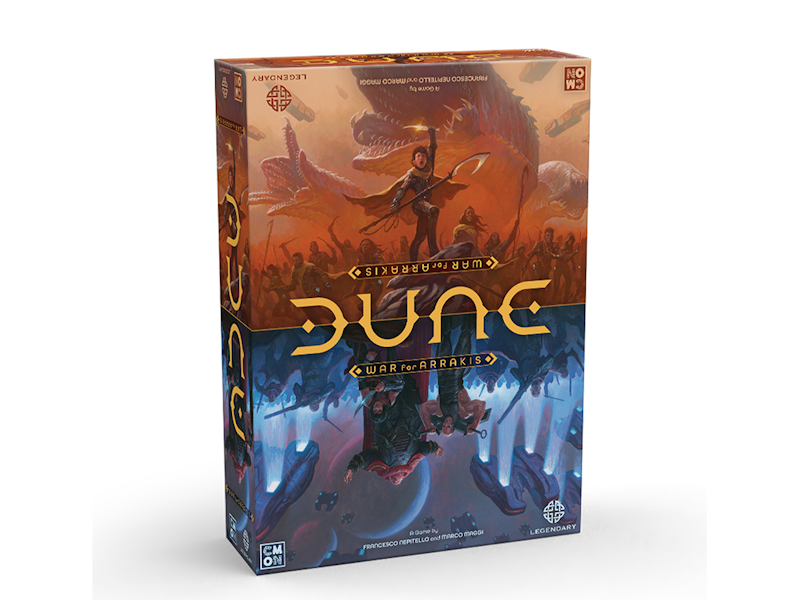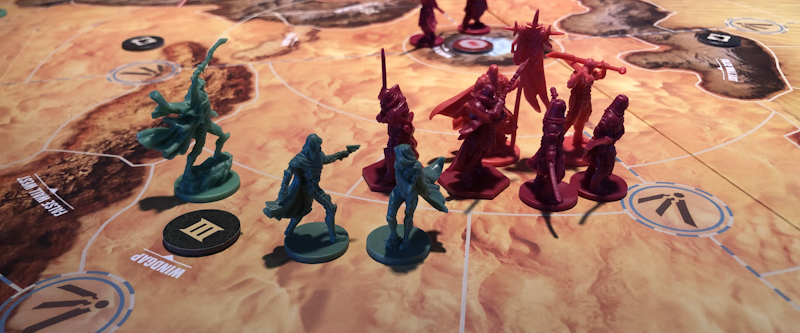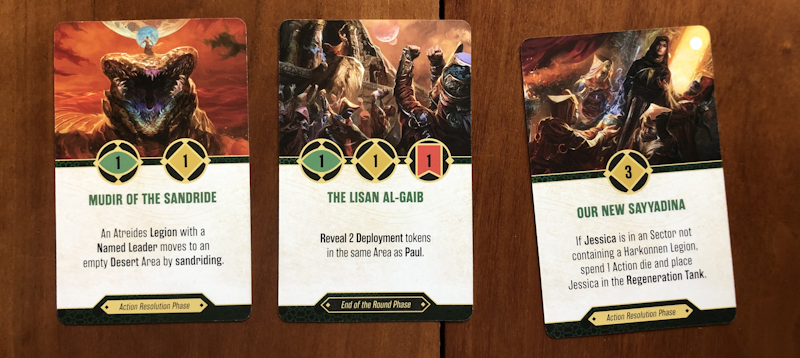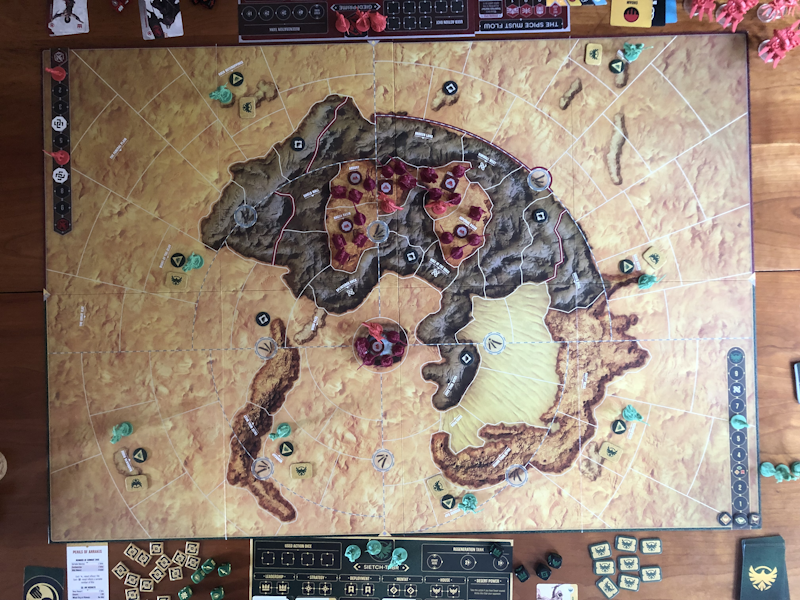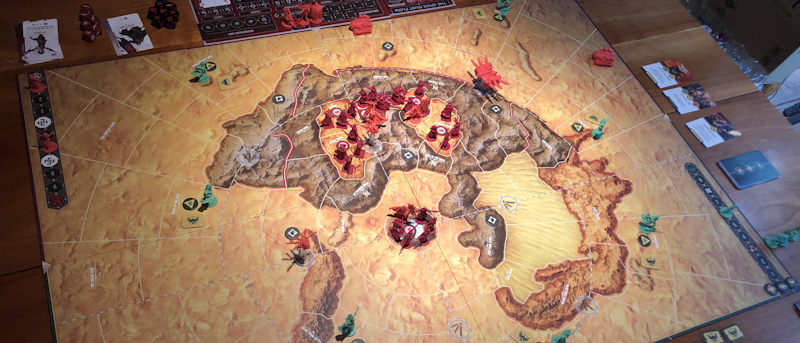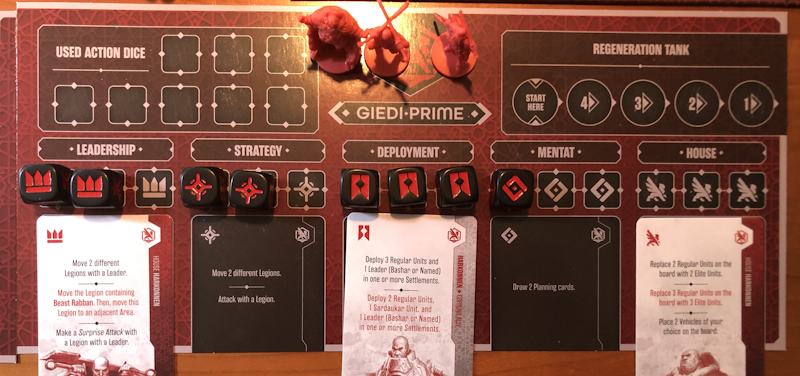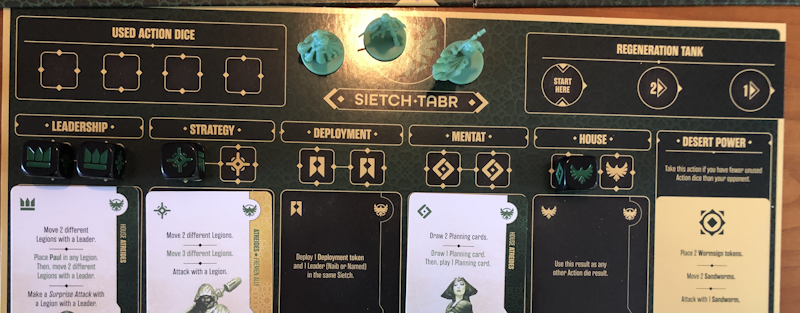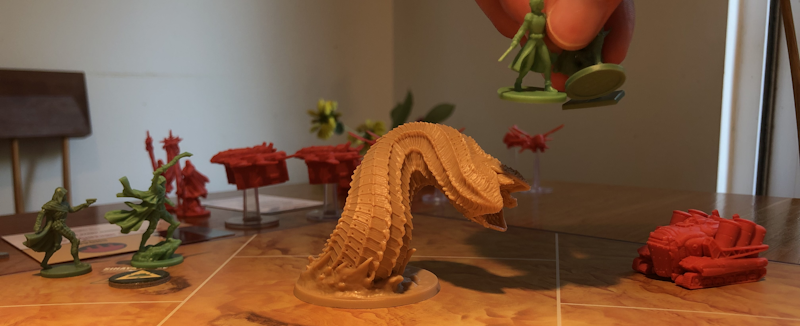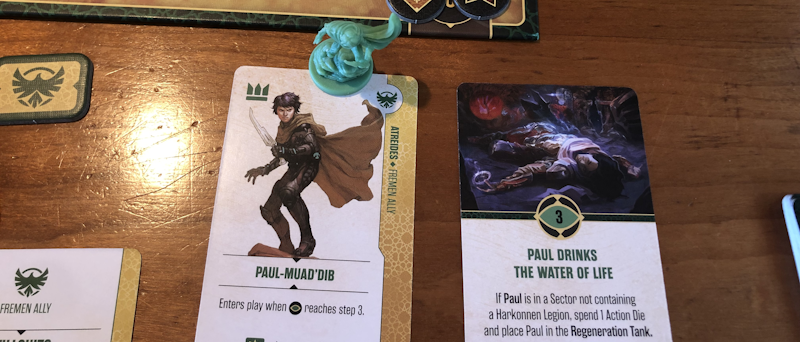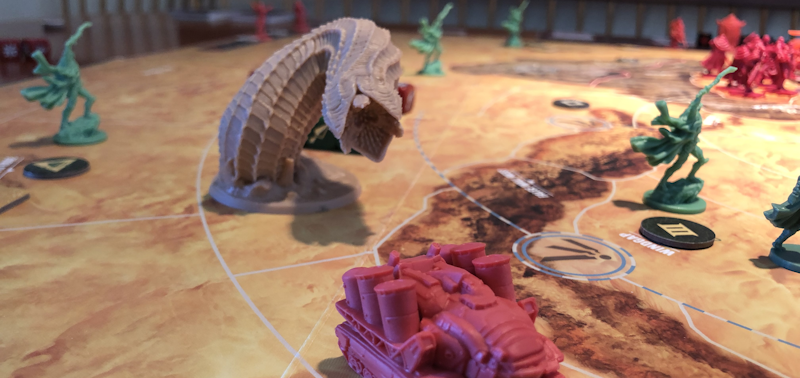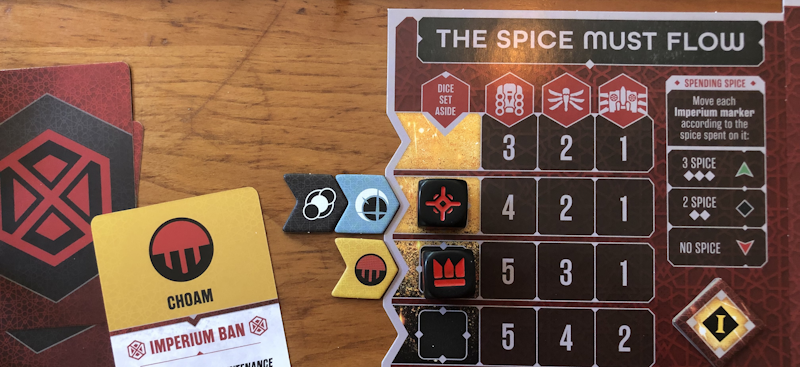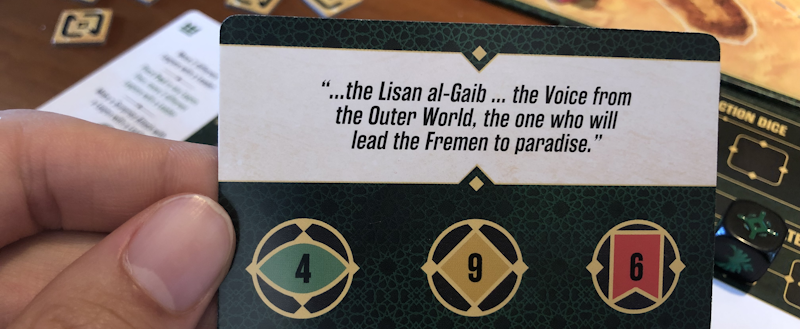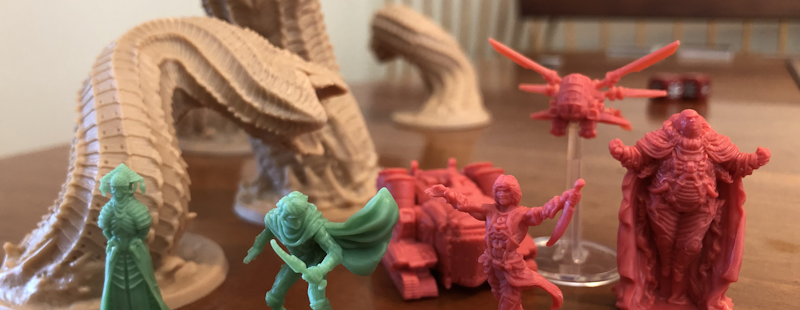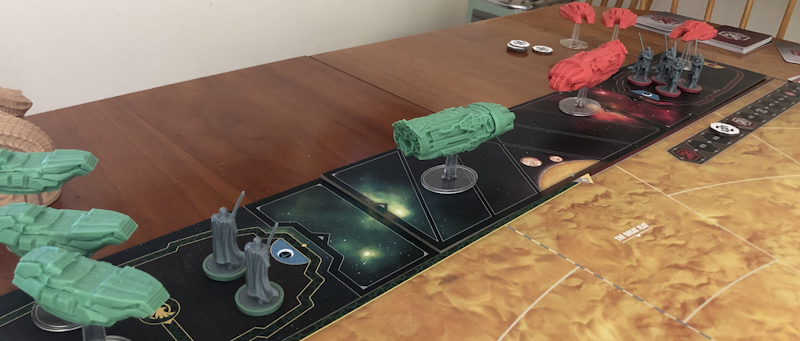Dune: War for Arrakis
review by Luka
WARNING: Minor Spoilers for Dune 2
What is Dune: War for Arrakis?
Do you love the Dune books and/or movies? Do you wish there was a wargame that featured all the major characters of the story where you can see Paul become Paul Muad’Dib? Do you want to fight with sandworms and harvest spice? If so, Dune: War for Arrakis is what you want! This game is a 2 player wargame with additional solo and 3-4 player modes that pits the Harkonnen and Corrino Houses against House Atreides and the Fremen as they fight for the future of Arrakis/the planet of Dune. Both factions have entirely different win conditions and play styles that are flavorful to the story. The Harkonnen player must use their superior action economy and military might to maintain their spice production and destroy the Fremen sietch settlements on the map to score points. Once they score 10 points, they win.
Harkonnen legion attacking a sietch worth 3 points
The Atreides/Fremen player has a secret objective determining how many points they need to score across 3 score tracks representing the progress towards Paul becoming the Kwisatz Haderach, the connection of Paul and Jessica to the Fremen culture, and the escalation of the holy war. The main way to score on these point tracks is to fulfill prescience cards which function like quests that represent different moments in the story, such as Lady Jessica becoming a Reverend Mother.
Prescience cards
Set Up Overview
Set up for Dune: War for Arrakis requires a large table to accommodate the combined game boards (19.5” x 27.5” approx each) that come together to form the north pole of Arrakis (39” x 27.5” total). In addition to the board there are also many additional game pieces including Atreides and Harkonnen player boards, a “Spice Must Flow” Harkonnen board, planning cards, Leader cards, Prescience cards, and a multitude of tokens and miniatures.
Gameplay Overview
The core gameplay loop is played in rounds. First, both players draw Planning cards which can be played for unique benefits, then the Atreides player reveals 3 Prescience cards, two of which they can attempt to score that round. Next, the Harkonnen player places Vehicles, which include Ornithopters to improve the movement of a Legion, Spice Harvesters to harvest spice from the deserts, and Carryalls to save Harvesters from Sandworm attacks.
Board after vehicles are deployed
Each player then rolls their Action dice and applies them to the proper spots on their player board; these dice determine what Actions players can do during this round. The Harkonnen player starts with 8 dice while the Atreides player starts with 4. The players then go back and forth, using an Action die to perform an Action. These include moving Legions (which consist of Units) from one area to an adjacent area, attacking with a Legion to an adjacent area containing an enemy Legion, deploying new Units, drawing more Planning cards, and a unique House specific action.
Harkonnen player board
The Harkonnens’ actions are more reliable when it comes to mustering and upgrading an army; thus enabling you to create a deathball of elites and Sardaukar led by powerful Leaders such as Beast Rabban to decimate the Fremen sietches. The Atreides, on the other hand, rely on secret information to fake out the power of Units on the board and the score value of each sietch. They must use guerilla tactics to score prescience cards to score and attack harvesters to hurt the Harkonnen’s spice production, which will invoke bans from the major trading guilds of the Imperium and cause them to lose action dice if the spice production is too low.
Atreides player board
Additionally, the Atreides player has the unique “Desert Action” which doesn’t use one of their 4 precious dice. These Desert Actions allow the Atreides player to place down Wormsign tokens and to move and attack with sandworms on the table! Additionally, the Wormsign tokens and worms themselves allow the Atreides player to sandride over them, creating opportUnities to travel and attack across the board!
Paul and his legion sandride the worm to attack a lone harvester
Players actions are made to be further unique through Leaders, which provide buffs to Legions on the board, and feature special actions that can be performed once per turn. Additionally, players unlock new characters or versions of characters through a variety of flavorful ways. For example, Paul becomes Paul Muad’Dib once the Atreides player scores at least 3 points in the Kwisatz Haderach point track, and it so happens that the Prescience card, “Paul Drinks the Water of Life,” scores you 3 Kwisatz Haderach points! Now the player has the option to use his unique ability to do a Desert Action first to prime a Legion’s move or attack via sandriding!
Once both players are out of action dice, the dangers of the desert beat down on the Harkonnen player. Sandworms can emerge from Wormsign tokens to attack isolated Legions and Harvesters, and Legions caught in the deserts are attacked by desert storms. Any remaining Harvesters then gather up the spice, with which the Harkonnen player spends on keeping the Spacing Guild, CHOAM, and Landsraad satisfied. Then the Atreides player checks to see if they won before moving into a new round.
The Spice Must Flow board; the CHOAM is not happy and the Harkonnen player loses 2 action dice along with an imposed ban
An example of an Atreides secret objective
Review
I love Dune: War for Arrakis. The rounds are structured fairly straightforwardly with an engaging alternating activation system while providing depth through the asymmetrical nature of the factions and the tactical decisions you must make through the dice you are dealt. The Spice Harvesters and Wormsign tokens also offer ways for each player to mess with each other’s long term game plans which is deeply appreciated for a war game such as this. Spice Harvesters can be attacked to prevent spice harvesting which may limit the Harkonnen player’s action economy in future rounds, and the Harkonnen player can step onto Wormsigns to potentially disrupt a long sandriding path the Atreides player was planning around.
While I am fairly new to Dune as a setting, Dune: War for Arrakis is a fantastic union of gameplay and flavor according to my somewhat limited knowledge, and according to my Dune-loving friend who played with me. The lore moments represented in the Prescience cards make you feel like you’re playing out the story while the spice harvesting embodies the pressure of the greater Imperium on the Harkonnen House. When characters are replaced by new characters—such as when Feyd Rautha replaces Beast Rabban—you are given not only progression of gameplay, but a sense of narrative progression. And when you attack via sandriding with Stilgar and Paul, sometimes you can’t help but shout, “Lisan Al Gaib!”
The miniatures themselves are also an attraction for me. While the designers could’ve implemented tokens for all the Units, miniatures impose a greater presence on the board. This is particularly true with the Leaders, Vehicles, and especially the sandworms which I find to be very fun to look at and pick up.
Furthermore, if you find yourself loving this game, the Spacing Guild expansion adds more depth to the spice harvesting aspect of the game. When spending spice on the Imperium factions as the Harkonnen player, or when attacking a Spice Harvester as the Atreides player, you can take an “Imperium Action.” These Actions allow the player to either move their Spacing Guild Heighliner closer to Arrakis, or add Landsraad Troops or CHOAM Frigates to their Spacing Guild Heighliner. Once their Heighliner reaches Arrakis, it deploys their load, giving the player huge benefits for the round via their accumulated Units and Frigates. As a result, spice harvesting becomes a more competitive aspect both players must consider.
Dune: War of Arrakis is definitely not for everyone due to the space, time, and attention it demands. However, these aspects also contribute towards memorable gaming experiences. The space and time emulate the scale of the War for Arrakis, and despite the playtime, the game never has a dull moment due to the back and forth moments and the unique player interactions that arise from the unique mechanics of each faction. As a result, the game designers have made an engaging, attractive, and flavorful game. I would especially recommend this game to people who want to emulate Dune as a wargame. And I would recommend Dune: War for Arrakis to friends or couples that want a competitive game they can really sink their teeth into.
Dune: War for Arrakis is available now from our webstore.
